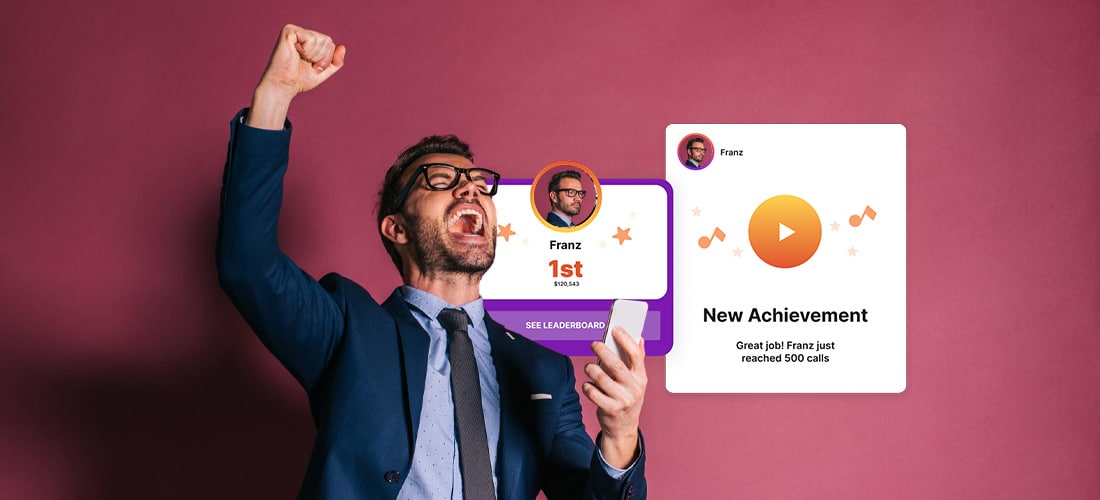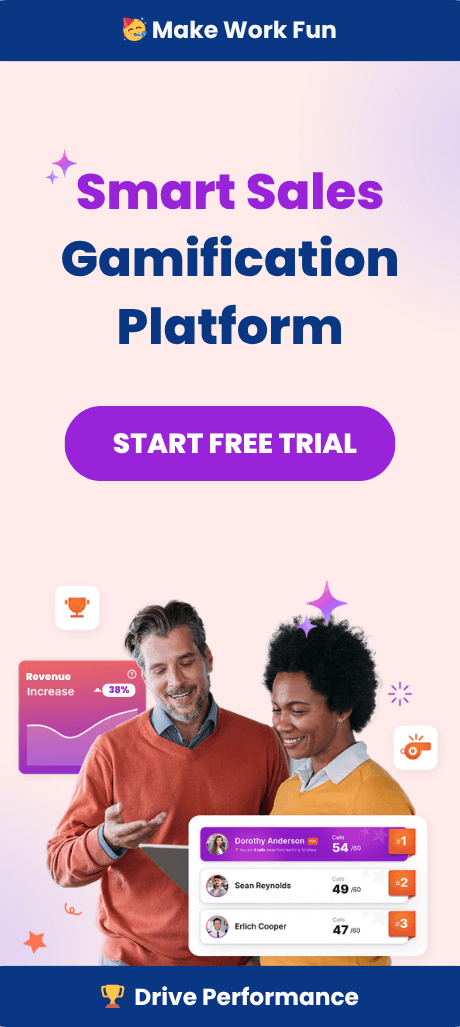In today’s workplace, employee motivation and engagement are key drivers of success, yet keeping teams inspired can often feel like a challenge. Enter gamification, a game-changing strategy that brings excitement, purpose, and recognition to everyday tasks. By incorporating point systems, leaderboards, and rewards into workplace activities, gamification transforms routine work into an engaging and rewarding experience.
Gamification loyalty programs take this concept further by transforming traditional loyalty programs into game-like experiences. Elements such as mobile-first apps, engaging quizzes, and fixed action rewards enhance customer engagement and drive repeat purchases, making the interaction between customers and brands more enjoyable and rewarding.
But what makes a points-based system so effective? And how can it be used to inspire employees, boost performance, and create a thriving workplace culture? In this blog, we’ll explore the power of gamification in the workplace, focusing on how rewarding employees with points can turn mundane tasks into meaningful milestones. Whether you’re looking to increase productivity, enhance learning, or simply make work more fun, this guide has all the insights you need to get started. Let’s dive in!
What is Gamification?
Gamification is the process of applying game-like elements, mechanics, and principles to non-game contexts to drive engagement, motivation, and behavior. It transforms everyday tasks into interactive and rewarding experiences by incorporating features like points, levels, badges, leaderboards, and rewards.
The goal of gamification is to tap into the human desire for achievement, competition, and recognition, making mundane activities more enjoyable and engaging. While commonly associated with customer-facing applications like loyalty programs, gamification has proven to be equally impactful in workplaces, learning environments, and employee engagement strategies. Loyalty gamification, in particular, enhances customer engagement and retention strategies by making loyalty programs more appealing through games and challenges. This not only increases consumer interaction and brand awareness but also boosts conversion rates and fosters a personal connection between customers and brands.
In the context of employee engagement, gamification focuses on enhancing productivity, teamwork, and skill development by introducing elements that encourage employees to achieve goals in a fun and competitive way.
Definition and Purpose
Gamification in loyalty programs is a powerful marketing strategy that leverages game design elements to engage customers and encourage desired behaviors. By incorporating features such as points, badges, and leaderboards, gamified loyalty programs create a fun and interactive experience that keeps customers coming back for more. The primary purpose of gamification in loyalty programs is to increase customer engagement and loyalty, ultimately driving business results.
Through gamification, brands can motivate customers to take specific actions, such as making purchases, sharing content, or referring friends. This interactive approach not only enhances the customer experience but also fosters a deeper connection between the brand and its customers. By making the process of earning rewards enjoyable and engaging, gamification encourages customers to participate more actively in the loyalty program, leading to increased customer loyalty and long-term brand loyalty.
Main Reasons to Use Gamification
Gamification is not just about making work fun—it’s a strategic tool that drives measurable results for both employees and organizations. Here are the main reasons to use gamification:
Boost Customer Engagement
- Gamification keeps employees actively involved by making tasks feel more rewarding and less routine. Engaged employees are more likely to stay focused and perform at their best.
2. Increase Motivation
- By tying actions to immediate rewards like points, badges, or recognition, gamification creates a sense of achievement that inspires employees to strive for more.
3. Foster Healthy Competition
- Leaderboards and team challenges encourage employees to compete in a positive way, driving better performance while strengthening team dynamics.
4. Improve Learning and Development
- Gamification enhances training programs by making them interactive and enjoyable. Employees retain knowledge better when learning feels like a game rather than a chore.
5. Recognize and Reward Achievements
- Public recognition through gamification builds morale and gives employees a sense of accomplishment. Rewards, whether tangible or virtual, reinforce desired behaviors.
6. Drive Productivity
- Gamified tasks encourage employees to meet deadlines, complete projects, or exceed performance goals. Tracking progress through points or levels helps them stay motivated to finish what they start.
7. Create a Positive Work Culture
- Gamification introduces an element of fun to the workplace, fostering a sense of community and collaboration among employees.
8. Retain Top Talent
- Engaged and motivated employees are more likely to stay with the organization. Gamification adds value to their day-to-day work, creating a sense of fulfillment and belonging.
By incorporating gamification into your organization’s strategy, you can unlock the potential of your team, create a culture of achievement, and drive meaningful results that benefit both employees and the business.
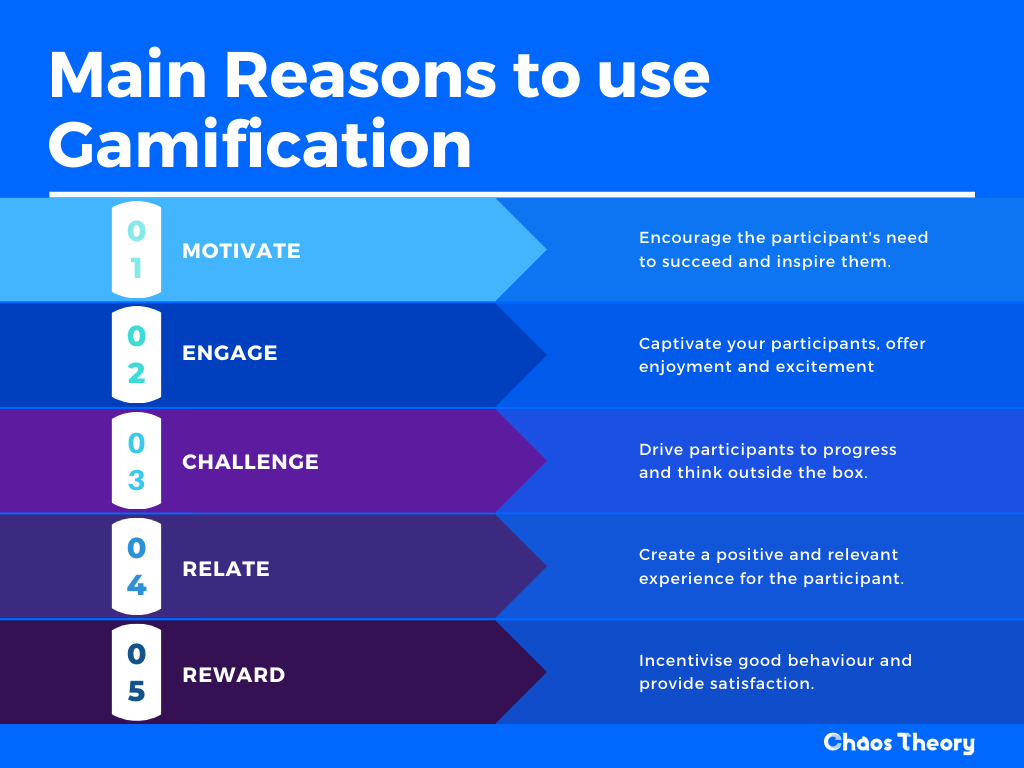
Psychology Behind Gamification
Gamification in loyalty programs taps into fundamental aspects of human psychology, particularly those outlined in Maslow’s Hierarchy of Needs: Love and Belonging, Self-Esteem, and Self-Actualization. By incorporating game-like elements, gamified loyalty programs engage the human psyche, motivating customers to interact with the brand and form new habits.
At the Love and Belonging level, gamification fosters a sense of community and connection among customers. Features like leaderboards and social sharing options allow customers to see their progress relative to others, creating a sense of belonging and camaraderie. At the Self-Esteem level, earning points, badges, and rewards provides a sense of accomplishment and recognition, boosting customers’ confidence and satisfaction. Finally, at the Self-Actualization level, gamification encourages customers to strive for personal growth and mastery, whether through achieving higher levels in the program or unlocking exclusive rewards.
By addressing these psychological needs, gamification creates a compelling and satisfying experience that encourages customers to take specific actions, such as making purchases or engaging with the brand. This, in turn, leads to increased customer loyalty and long-term engagement.
Loyalty Program Point System for Employees
Gamification mechanics revolve around using features from games for workplace purposes, and a point system is one of the most effective strategies to implement. Essentially, gamification offers a range of options to customize and create an engaging approach for motivating employees and driving results.
What are gamification points in the workplace? These are points employees receive for completing specific actions, much like players earn points for achievements in a game. These actions could include reaching sales goals, completing training modules, collaborating on projects, or meeting deadlines.
The gamification point system serves several purposes in an employee-focused context. For example, you can use points to reward goal completion, performance milestones, or skill development. Since people enjoy being recognized for their achievements, points can also be a way to foster healthy competition and boost team morale. In some cases, a point system can even unlock tangible rewards, such as gift cards, extra vacation days, or professional development opportunities.

Scores and points motivate employees by creating a clear and engaging pathway for progress. Employees are more likely to stay engaged, perform better, and participate actively in workplace initiatives when they know their efforts lead to recognition or rewards. By achieving milestones and earning points, employees stay motivated to continue excelling, creating a cycle of continuous growth and achievement.
Gamification points can lead to both virtual and concrete benefits in the workplace. The key is to ensure employees understand that their points have value and contribute to a meaningful experience. Whether it’s public recognition, exclusive rewards, or career development opportunities, a point system helps create a more engaging and fulfilling work environment for everyone involved.
Why do gamification points work?
Gamification points work because they tap into fundamental human psychology, creating a sense of achievement, progress, and motivation. By leveraging concepts like goal-setting, instant feedback, and rewards, points keep employees engaged and inspired to perform better. Here’s why they are so effective:
- Clear Goals and Motivation
Points provide employees with a clear objective to work toward. Whether it’s earning points for completing tasks, exceeding targets, or collaborating with peers, they act as tangible markers of success. This clarity motivates employees to stay focused and strive for their goals. - Instant Recognition
Earning points offers immediate feedback and recognition for an employee’s efforts. Unlike traditional performance reviews that happen quarterly or annually, gamification points provide real-time acknowledgment, boosting morale and reinforcing positive behaviors. - Healthy Competition and Social Status
Points encourage friendly competition within teams, fostering a culture of engagement and collaboration. Public leaderboards or recognition for top performers can further enhance this dynamic, giving employees a chance to showcase their progress and achievements. - Sense of Progression
Accumulating points provides employees with a visible sense of progression. As they earn points, they can see how their efforts contribute to their overall growth and success. This progression fuels a sense of purpose and encourages continuous improvement. - Rewards and Incentives
Points often lead to tangible or experiential rewards, such as gift cards, days off, or exclusive opportunities. Knowing that their efforts translate into meaningful benefits keeps employees motivated and invested in their work. - Engagement Through Gamification
The gamification element makes routine tasks more enjoyable and interactive. Instead of viewing their work as monotonous, employees feel like they are part of a dynamic and engaging system where their efforts are acknowledged and rewarded.
By combining intrinsic motivators, like the satisfaction of achievement, with extrinsic rewards, gamification points create a well-rounded system that encourages employees to stay engaged, productive, and aligned with organizational goals.Where to apply gamification points?
That’s the beauty of a gamified loyalty program – you can apply it across different industries. The Gamification points system isn’t limited to a specific niche.
Whether you own a business or brand that wants to boost sales, a marketer conducting research, a lecturer providing courses, a fitness trainer, an app developer, or something else, gamification can work for you. And so can the points system!
Types of Gamification Rewards
Gamification rewards come in various forms and are designed to cater to both intrinsic and extrinsic motivations. When implementing a gamification strategy for employees, offering a mix of reward types ensures broader appeal and sustained engagement. Here are the main categories of gamification rewards:
1. Tangible Rewards
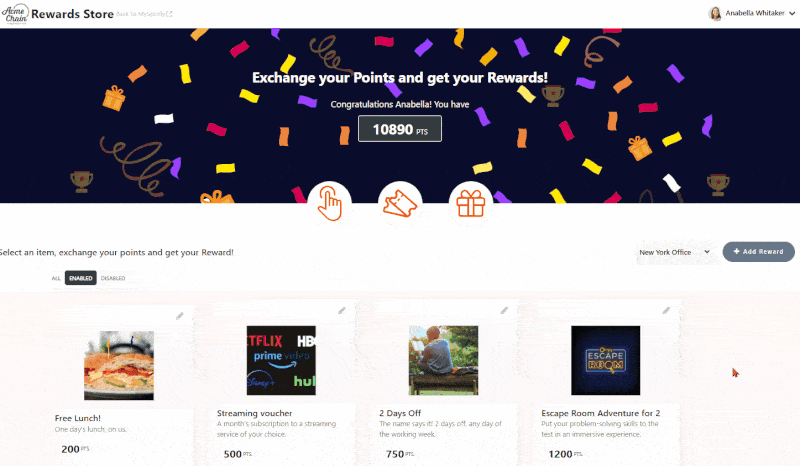
Tangible rewards provide physical or monetary value, making them highly motivating for employees. These rewards are easy to quantify and can directly impact employee satisfaction. Examples include:
- Gift Cards: Versatile and customizable for individual preferences.
- Extra Paid Time Off (PTO): Rewarding employees with a day or two off for high performance.
- Office Perks: Items like upgraded desk setups, ergonomic chairs, or company swag.
- Financial Bonuses: Direct monetary rewards based on point accumulation.

2. Experiential Rewards
Experiential rewards create lasting memories and can significantly enhance morale. They are particularly effective for fostering a sense of appreciation and team spirit. Examples include:
- Team Outings: Organizing escape rooms, dinners, or adventure activities.
- Training and Development: Access to specialized workshops, certifications, or online courses.
- Travel Opportunities: Fully or partially sponsored trips as a reward for exceptional performance.
Social Recognition Rewards for Brand Loyalty
Social recognition leverages the desire for acknowledgment and status within a group. These rewards are often intrinsic and help create a culture of appreciation. Examples include:
- Ring the Gong: Celebrating achievements with a physical or virtual gong that employees can “ring” when they hit a major milestone. It’s a fun, immediate way to share success across the team.
- Leaderboards: Highlighting top performers in public spaces or on internal platforms.
- Employee of the Month: A title or badge that comes with recognition across the organization.
- Shoutouts: Public praise during meetings or on internal communication platforms.
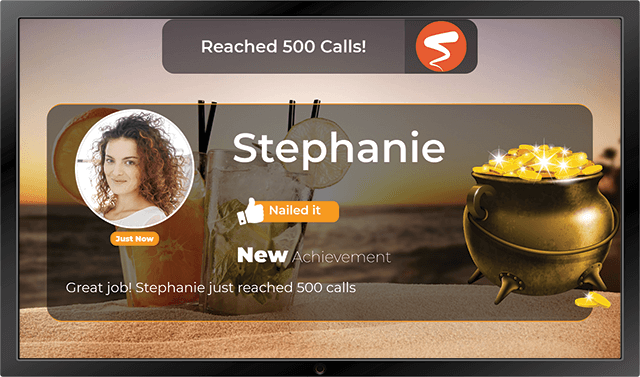
4. Virtual Rewards
Virtual rewards are cost-effective and especially relevant for remote teams or digital workplaces. These rewards can be just as impactful as tangible ones when implemented creatively. Examples include:
- Digital Badges: Representing achievements, such as “Top Performer” or “Collaboration Champion.”
- In-App Upgrades: Exclusive features or benefits within company tools or platforms.
- Custom Avatars or Themes: Unlockable personalization options for internal gamified platforms.
5. Progress-Based Rewards
Progress-based rewards focus on providing benefits as employees achieve certain milestones. These rewards encourage continuous engagement and effort over time. Examples include:
- Levels and Tiers: Unlocking higher levels of recognition or access to perks as employees reach milestones.
- Unlockable Content: Exclusive access to new resources, tools, or knowledge for reaching set goals.
- Achievement Milestones: Celebrating significant accomplishments with tailored rewards.
6. Team-Based Rewards
To encourage collaboration and teamwork, team-based rewards align incentives across groups. Examples include:
- Shared Bonuses: Rewards distributed equally among team members for achieving collective goals.
- Team Celebrations: Lunches, happy hours, or team-building activities for hitting targets.
- Group Recognition: Highlighting team achievements in newsletters or town halls.
7. Personalized Rewards
Loyal customers demonstrate that the organization values employees as individuals. Examples include:
- Custom Rewards: Allowing employees to choose their rewards based on accumulated points.
- Anniversary or Birthday Perks: Special recognition or gifts for personal milestones.
- Tailored Incentives: Rewards aligned with an employee’s specific interests, such as concert tickets or books.
By offering a diverse mix of rewards, including memorable activities like ringing the gong, organizations can engage employees at different levels, ensuring sustained participation and enthusiasm in their gamification programs. The right balance between tangible, experiential, and recognition-based rewards helps create a motivational system that drives both individual and organizational success.

8. Fixed Action Rewards
Fixed Action Rewards are a cornerstone of many successful loyalty programs, providing customers with clear and predictable incentives for their actions. In a Fixed Action Reward system, customers know exactly what they need to do to earn a reward, whether it’s making a certain number of purchases, accumulating points, or completing specific tasks. Examples of Fixed Action Rewards include loyalty programs, frequent flyer miles, and punch cards at coffee shops.
These rewards are highly effective in building customer loyalty because they tap into three Left Brain Core Drives: Development & Accomplishment, Ownership & Possession, and Scarcity & Impatience. Customers feel a sense of accomplishment as they work towards a known goal, and the tangible nature of the rewards reinforces their sense of ownership and value. Additionally, the scarcity of rewards—knowing that they must act within certain parameters to earn them—creates a sense of urgency and motivation.
By providing clear and attainable goals, Fixed Action Rewards encourage customers to engage more frequently with the brand, fostering loyalty and repeat business.
9. Sudden and Random Rewards
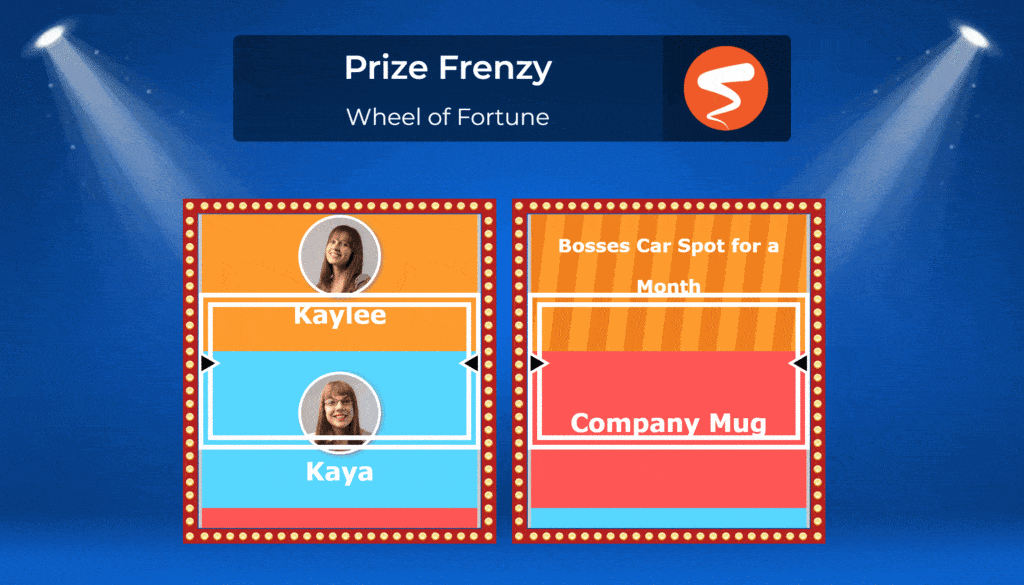
Sudden and Random Rewards add an element of surprise and excitement to loyalty programs, making the customer experience more dynamic and engaging. Sudden Rewards are unexpected bonuses that customers receive without prior notice, creating a delightful surprise that enhances their overall experience. For example, a customer might receive a surprise discount or a free gift after making a purchase, even though they weren’t expecting it.

Random Rewards, on the other hand, are given based on completing a required action, but the specific reward remains unknown until it is received. This unpredictability creates a sense of anticipation and excitement, much like the feeling of opening a gift on Christmas morning. Customers are motivated to participate in the hope of receiving a valuable or unique reward, which keeps them engaged and eager to interact with the brand.
Both Sudden and Random Rewards are effective in increasing customer engagement and loyalty because they create positive word-of-mouth and speculation among customers. The element of surprise and the potential for unexpected rewards make the loyalty program more intriguing and enjoyable, encouraging customers to stay active and engaged. By incorporating these types of rewards, brands can foster a sense of excitement and loyalty that keeps customers coming back for more.
How to apply gamification points to reward users?
Gamification points are a fantastic strategy because there are no specific rules. Loyalty program gamification provides customers with clear and predictable incentives for their actions. Your imagination plays the most crucial role here.
All you need to do is think of different ways to reward customers for their actions and how many points you will give them for each activity. Here are a few examples.
Measuring the Effectiveness of Gamification
Implementing a gamification strategy is just the beginning—measuring its effectiveness is essential to ensure it delivers value to both employees and the organization. By tracking the right metrics and gathering feedback, you can assess the impact of your gamification program and make data-driven improvements. Here are key approaches to measuring its success:
1. Participation and Engagement Rates
- Track how many employees actively participate in the gamification program to assess the effectiveness of loyalty strategies.
- Monitor engagement metrics, such as the frequency of login to the platform, the number of actions completed, or points earned.
- High participation and engagement indicate that employees find the program motivating and enjoyable.
2. Performance Metrics
- Compare performance data before and after implementing gamification. For example:
- Sales Teams: Measure increases in sales, closed deals, or revenue.
- Customer Support Teams: Assess improvements in response times or ticket resolution rates.
- Training Programs: Track course completion rates and knowledge retention scores.
- Identify whether gamification helps employees achieve their goals more efficiently.
3. Goal Achievement
- Evaluate whether employees are meeting the objectives tied to gamification. This might include completing specific tasks, hitting milestones, or reaching KPIs.
- Review goal progression to see if gamification accelerates achievement timelines.
4. Employee Feedback
- Collect qualitative data through surveys, focus groups, or one-on-one discussions.
- Ask employees how they feel about the gamification program: Is it motivating? Does it help them stay focused? Are the rewards meaningful?
- Use feedback to identify areas for improvement or expansion.
5. Retention and Turnover Rates
- Measure employee retention rates before and after introducing gamification. Engaged employees are more likely to stay with the organization.
- If turnover decreases, it may signal that gamification contributes to a positive work environment.
6. Productivity Levels
- Analyze productivity metrics to determine if employees are completing more tasks or working more efficiently after gamification is introduced.
- Look for patterns where gamified elements drive measurable increases in output.
7. Collaboration and Team Dynamics
- Observe how gamification impacts teamwork. Metrics such as collaboration frequency, peer recognition, or team-based goal achievement can provide insights into whether gamification fosters stronger team connections.
8. Reward Redemption Rates
- Monitor how often employees redeem their points or rewards. A high redemption rate indicates that rewards are both attractive and attainable, keeping employees motivated.
9. ROI (Return on Investment)
- Assess the financial impact of gamification by comparing the cost of implementation (platform, rewards, etc.) with the tangible benefits, such as increased revenue, reduced churn, or lower training costs.
- Calculate the ROI to determine whether the program delivers measurable business value.
10. Adaptability and Scalability
- Evaluate how well the gamification program adapts to changing needs or scales with your growing workforce.
- Identify if the program continues to engage employees over time or requires updates to maintain effectiveness.
By combining quantitative metrics with qualitative insights, you can determine whether gamification is achieving its intended purpose: increasing employee engagement, motivation, and productivity while contributing to organizational success. Regularly reviewing these measurements ensures that your gamification strategy evolves to meet both employee and business needs.
Spinify Makes Gamification Simple
Gamification isn’t just a trend—it’s a proven strategy to engage employees, boost productivity, and foster a positive workplace culture. By rewarding employees with points, you’re creating an environment where achievements are recognized, progress is celebrated, and motivation thrives.
Spinify makes implementing gamification seamless and impactful. With customizable leaderboards, points systems, and meaningful rewards, Spinify turns everyday work into an engaging and rewarding experience. Whether you’re looking to drive sales, improve team collaboration, or enhance training programs, Spinify’s innovative platform is designed to motivate employees and align their efforts with your organizational goals.
With Spinify, you can easily track performance, celebrate milestones, and keep your team excited about their progress—all while building a thriving workplace culture. Ready to transform your workplace with gamification? Spinify is your ultimate solution to reward, recognize, and inspire your employees like never before. Let’s get started! 🚀
Our easy-to-use gamification tools will not only boost your team’s performance, but also make your team excited to work.
Book a demo today and discover how we can help make your gamification journey simple.
